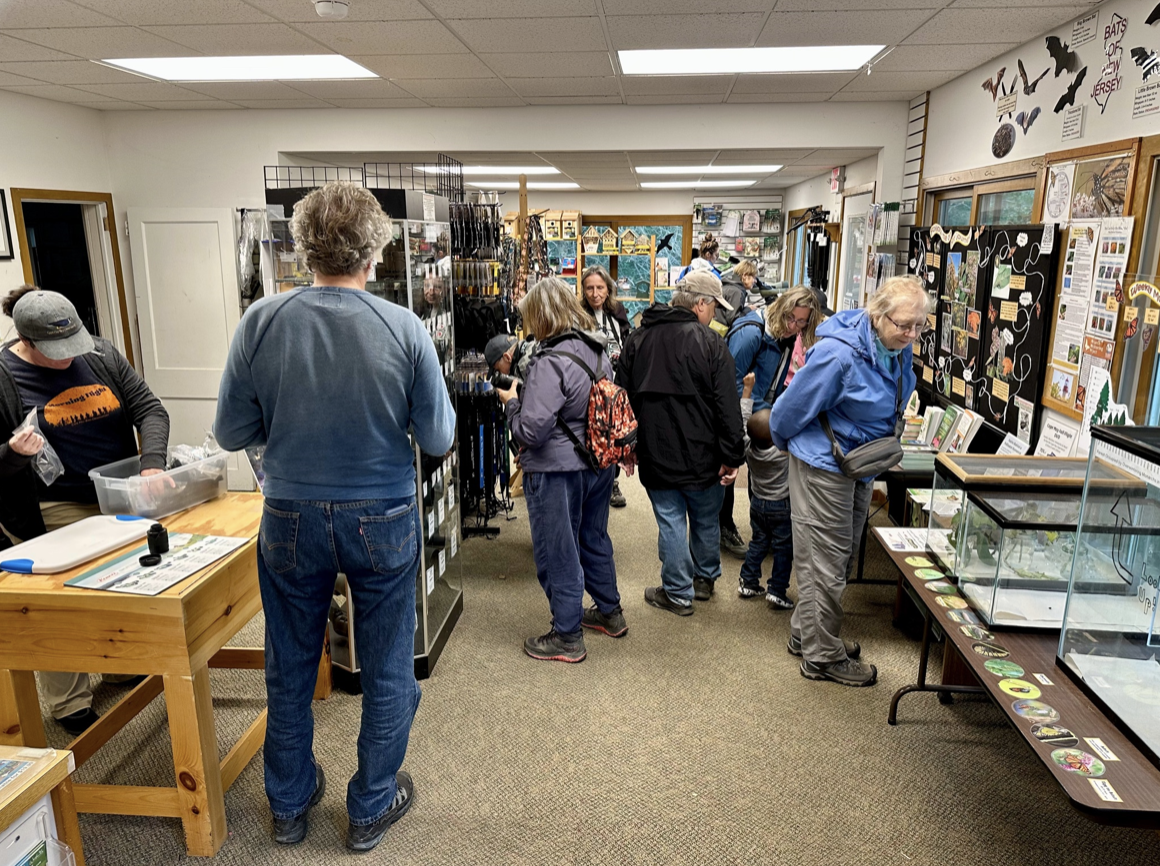Photo: Sanderling, Ron Grimes
Andreana Lin
On the weekend of October 7-8, 24 birders traveled with ASNV to Cape May, New Jersey, a prime spot for birders, for an adventure witnessing fall migration. Board member and George Mason University Professor Tom Wood, Adult Education Committee member Larry Meade, and Northern Virginia Community College Professor Herlitz Davis led the trip.
Cape May is one of the best places in North America to witness fall migration. It is a world-renowned destination, and birders flock here to witness a natural history phenomenon of ancient origin. The first half of October is a good time to see a variety of species accumulate on the southern end of this New Jersey coastal peninsula, preparing to cross the Delaware Bay on their journey south. Hawks, passerines, shorebirds, and waterfowl all make the journey, and, under the right weather conditions, can be seen in abundance.
ASNV birders watching migrating birds from the hawkwatch platform, Andreana Lin.
Our group traveled together in vans from Fairfax to the ferry terminal in Lewes, Delaware, where the adventure began. We were able to sharpen our gull identification skills from the wharf and on the ferry as we crossed the Delaware Bay to Cape May. Upon landing in Cape May, we drove a short way to the Cape May Hawkwatch. The watch platform was full of birders, and together we observed Peregrine Falcons, Merlins, Sharp-shinned and Cooper’s Hawks, Bald Eagles, American Kestrels, White Ibises, and much, much more streaming south. We also walked the local trails and observed huge flocks of staging Tree Swallows fueling up on bayberries for their strenuous flight ahead. As happens most years, there was a displaced Eurasian Wigeon among a mixed group of waterfowl.
A tagged monarch butterfly ready for release, Scott Ableman
A public demonstration at the hawkwatch pavilion gave us the chance to observe New Jersey Audubon releasing tagged monarch butterflies as part of its Monarch Monitoring Project.
At the end of this successful day of observing nature at its best, we made a stop at the Cape May Bird Observatory Northwood Center, a must-stop-shop for birders and wildlife lovers alike with a wide variety of scopes, binocular accessories, bird feeders, pollinator hotels, field wear, and nature-themed books.
Inside the Northwood Center, Tom Wood
Bordering the North Atlantic Ocean, the Avalon Seawatch is famous for its spectacular migratory bird count, averaging nearly 800,000 seabirds each year. Photo: Andreana Lin
Day 2 of the trip brought us to the Avalon Seawatch bright and early in the morning. We walked around the beach to the official Seawatch observatory, spotting Laughing Gulls, Caspian Terns, Brown Pelicans, Double-crested Cormorants, a Parasitic Jaegar, Forster’s Terns, Green-winged Teal, and Semipalmated Sandpipers. Conspicuously late this year, we did not see any Surf or Black Scoters that are often counted in the thousands per day mid-October.
Dolphin calf swimming with its mother. Photo: Austin & Haocong Ren.
The Avalon Seawatch also is a good location for watching dolphins, and we were treated to the sight of a bottlenose dolphin with her calf.
Our morning on the beach passed quickly, and soon it was time to leave. We brushed the sand off our boots and headed back to Cape May. Back at the hawkwatch, we saw more Sharp-shinned and Cooper's Hawks and observed raptor banding at the pavilion.
The Nature Conservancy’s pollinator garden, Andreana Lin
Our final stop before returning home was at South Cape May Meadows. This was a special stop because of the tremendous conservation value of the land The Nature Conservancy has preserved. Its conservation projects there include stopover banding for passerines in the fall. This banding station provides data demonstrating the importance of intact natural habitat where birds can rest and refuel during migration. Skilled banders gave us a close look as they gently released Common Yellowthroats and a female Indigo Bunting caught toward the end of the day’s banding session.
After the songbird banding demonstration, we explored one of the meadow’s trails, adding a few more species to the record for our trip. You can see the complete list of sightings for the trip here.
Judy Gallagher, ASNV board member and regular contributor to the Potomac Flier, said it best: “The joy you get from discovering something new—that's the best part about trips like this.”
ASNV Cape May trip participants








